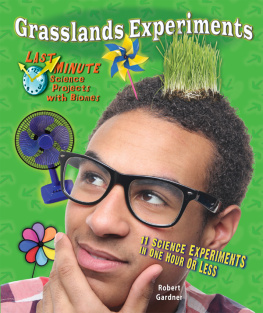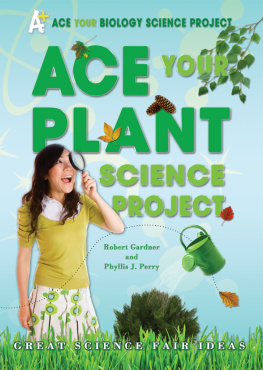SCIENCE AND MATH-WHAT A TEAM!
Math and measurements have played a big role in scientific discovery since ancient times. Use math and measurement to figure out how big a raindrop is, discover the first units of measure, and more! Learn about the scientific method with the great experiments in this book. Many experiments include ideas you can use for your science fair project.
About the Author
ROBERT GARDNER is a retired high school teacher of physics, chemistry, and physical science, who enjoys writing, biking, and doing volunteer work.

When you hear the word science, do you think of a person in a white lab coat surrounded by beakers of bubbling liquids, specialized lab equipment, and computers? What exactly is science? Maybe you think science is only a subject you learn in school. Science is much more than this.
Science studies the things that are all around you, every day. No matter where you are or what you are doing, scientific principles are at work. You dont need special materials or equipment, or even a white lab coat, to be a scientist. Materials commonly found in your home, at school, or at a local store will allow you to become a scientist and pursue an area of interest. By making careful observations and asking questions about how things work, you can begin to design experiments to investigate a variety of questions. You can do science. You probably already have but just didnt know it!
Perhaps you are reading this book because you are looking for an idea for a science fair project for school, or maybe you are just hoping to find something fun to do on a rainy day. This book will give you an opportunity to learn more about math and to make many kinds of measurements. Science is based on measurements, and if you want to do science, you need to know how to measure things. You also need to be familiar with the units of measurement that scientists use. This book introduces you to math and measuring through experiments that are enjoyable to do. It will explore topics like early methods of measuring, the U.S. customary system of measurements, the metric system, and the Pythagorean theorem. It will provide opportunities to measure area, volume, mass, density, and temperature. If you are interested in making indirect measurements or estimates, there is sure to be something to catch your interest in the last chapter. You will learn scientific principles that will help you expand your understanding of both math and science.
All scientists look at the world and try to understand how things work. They make careful observations and conduct research about a question. Different areas of science use different approaches. Depending on the phenomenon being investigated, one method is likely to be more appropriate than another. For example, a scientist designing a new medication for heart disease would require a vastly different method than one studying the spread of an invasive plant species such as purple loosestrife or exploring whether there was once water on Mars.
Despite the differences, however, all scientists use a similar general approach to experiments. This approach is called the scientific method. In most experiments, some or all of the following steps are used: making observations, formulating a question, making a hypothesis (an answer to the question), predicting (making an if-then statement), designing and conducting an experiment, analyzing results and drawing conclusions, and accepting or rejecting the hypothesis. Scientists then share their findings with others by writing articles that are published in journals. After and only aftera hypothesis has repeatedly been supported by experiments can it be considered a theory.
You might be wondering how to start an experiment. When you observe something in the world, you may become curious and think of a question. Often, your question can be answered by a well-designed investigation. Your question may also arise from an earlier experiment or from background reading. Once you have a question, you should make a hypothesis, which is a possible answer to the question (what you think will happen). Once you have a hypothesis, it is time to design an experiment. In most cases, it is appropriate to do a controlled experiment. This means you use two groups and treat them exactly the same except for the single factor that you are testing. That factor is called a variable. For example, if you want to investigate whether adding salt to water affects the time it takes the water to boil, two groups should be used. One group is called the control group and the other is called the experimental group. The two groups should be treated exactly the same: The same amount of water should be used, the water should be heated in the same way, and so forth. However, the variablesaltwill be different. The control group will contain pure water while the experimental group will contain saltwater. The variable is the only difference between the two groups.
During the experiment, you will collect data. For example, you might record the temperature of the liquid each minute, then note the temperature and time at which the liquid begins to boil. You might make observations of each liquid along the way. By comparing the data collected from the control group with the data collected from the experimental group, you will draw conclusions. Since the water samples were tested under the exact same conditions with the exception of the addition of the salt to the water, boiling of the saltwater at a higher temperature would allow you to conclude with confidence that this is the result of the salt being added to the water.
Two other terms that are often used in scientific experiments are dependent and independent variables. One dependent variable in the example is the boiling temperature of the liquid, because, in this case, it depends upon whether or not salt was added. The addition of salt is the independent variable (it doesnt depend on anything). After the data is collected, it is analyzed to see whether the hypothesis was supported or not. Often, the results of one experiment will lead you to a related question, or they may send you off in a different direction. Whatever the results, there is something to be learned from all scientific experiments.
Many of the experiments in this book may be appropriate for science fair projects. Experiments marked with a symbol ( ) include a section called Science Fair Project Ideas. The ideas in this section will provide suggestions to help you develop your own original science fair project. However, judges at such fairs do not reward projects or experiments that are simply copied from a book. For example, models of geometric solids (cones, cylinders, cubes, spheres) and their surface areas or volumes would probably not impress judges unless they were done in a novel or creative way. On the other hand, a carefully performed experiment to determine how the surface area of an object affects the rate at which it loses heat would be likely to receive careful consideration.
) include a section called Science Fair Project Ideas. The ideas in this section will provide suggestions to help you develop your own original science fair project. However, judges at such fairs do not reward projects or experiments that are simply copied from a book. For example, models of geometric solids (cones, cylinders, cubes, spheres) and their surface areas or volumes would probably not impress judges unless they were done in a novel or creative way. On the other hand, a carefully performed experiment to determine how the surface area of an object affects the rate at which it loses heat would be likely to receive careful consideration.
Science fair judges tend to reward creative thought and imagination. It helps if you are really interested in your project. Take the time to choose a topic that really appeals to you. Consider, too, your own ability and the cost of materials. Dont pursue a project that you cant afford.
If you decide to use a project found in this book for a science fair, look for ways to modify or extend it. This should not be difficult because you will probably find that as you do these projects, new ideas for experiments will come to mind. These new experiments could make excellent science fair projects, particularly because they spring from your own mind and are interesting to you.


















 ) include a section called Science Fair Project Ideas. The ideas in this section will provide suggestions to help you develop your own original science fair project. However, judges at such fairs do not reward projects or experiments that are simply copied from a book. For example, models of geometric solids (cones, cylinders, cubes, spheres) and their surface areas or volumes would probably not impress judges unless they were done in a novel or creative way. On the other hand, a carefully performed experiment to determine how the surface area of an object affects the rate at which it loses heat would be likely to receive careful consideration.
) include a section called Science Fair Project Ideas. The ideas in this section will provide suggestions to help you develop your own original science fair project. However, judges at such fairs do not reward projects or experiments that are simply copied from a book. For example, models of geometric solids (cones, cylinders, cubes, spheres) and their surface areas or volumes would probably not impress judges unless they were done in a novel or creative way. On the other hand, a carefully performed experiment to determine how the surface area of an object affects the rate at which it loses heat would be likely to receive careful consideration.